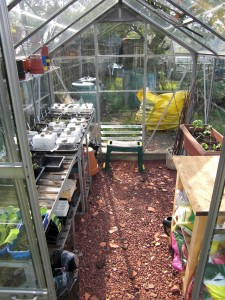“A Word …” is my quarterly column for Landscape: The Journal of the Landscape Institute. Here in the Winter 2015 issue I talk about how nurturing plants and creative and community interests are essential for both children and for the future of our landscapes.

Seedlings growing in my North Sheen allotment greenhouse – sadly I had to give up the allotment when I moved some years ago.
When I was eleven years old, I can recall standing before the bench in the small greenhouse at the Chartridge School in Chesham, Buckinghamshire and being struck by a bolt of green lightning. At that age and height I was not far from eye level with new seedlings pushing their way up through the compost. The wonder of that moment when seed becomes plant became suddenly clear to me, and filled me with a sort of electricity that has always since arced and sparked whenever I’m presented with another opportunity to nurture a plant.
I filled my bedroom windowsill with pelargoniums of the most mundane green-leaves-with-red-blossom kind. They filled my room with their odd, pungent scent mixed with the smell of moist soil and terra cotta. My parents entrusted a small corner of the garden to me where I could inflict the least damage on the grounds of our rented house, and I’m quite certain that, though I didn’t discover landscape architecture as a profession until I was in my 30s, that it was then that my journey into the profession began. Over the years, though, I’ve moved around too much ever to properly have a garden of my own, so I suppose it is fitting that I should be occupied with making landscapes for others.
As a child in an American military family I was moved from place to place roughly every two years, and I continued that restless movement, perhaps out of habit, for much of my early adulthood. Thus it has taken me a long time to come to the understanding just how privileged my upbringing was. Far from an experience of rootlessness, I’ve learned to put down roots quickly. When I think of ‘home’ I think of London–but then I also think of a handful of other places where I’ve made myself at home. I’m one of the lucky immigrants–a garden-worthy species that thrives in a variety of soils. I’m also terribly lucky to have attended a primary school with a greenhouse, to have had a small patch of soil to tend, to have had friends and clients with gardens that needed my attention over the years.
Currying an interest in landscape amongst the young begins at the crucial early stages; through a dalliance with plants leading to passion, civic involvement, and/or immersion in the arts. When we wonder why it is hard to bring young people into landscape architecture, it is that so few of them have access to or involvement with these things any more. I have spoken about my experience as one of privilege, and indeed it was, but it shouldn’t be. A simple combination of access to a small patch of earth to sow in, to play a musical instrument or to draw pictures, and the duty and pleasure of involvement in community, society, and culture–these should be cheaply or freely accessible to all–and they’re not privilege, they’re necessities.
This said, I’m not pessimistic about the future of landscape architecture (or the arts, or civics). I think we’re just at a cultural and political low point of obsession with objects over contexts, personal gain over public wellbeing, ‘growth’ over nurturing, cold hard cash over art. And we’re already climbing out of that pit of despair. Landscape architecture and the landscape professions, however they are named or constituted in the future, will remain essential to civic life, the arts, and, of course, the environment. In our short history as a profession, we’re just a seedling, filling out our foliage, preparing to bloom.